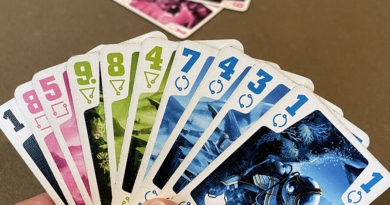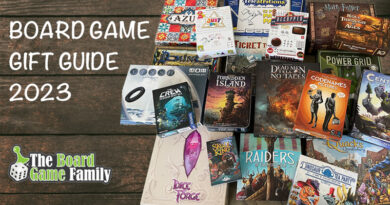Let’s get us some Rune Stones!
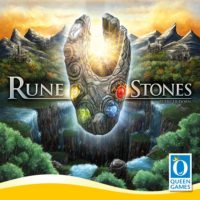
Do you like deck-building games like Dominion, Clank!, Legendary, and Thunderstone Quest?
What about resource-collecting/converting games like Century: Golem Edition?
How would you like a game that mixes those game mechanisms together?
Well, that’s what you get with Rune Stones by Queen Games!
At SaltCon 2020, I was able to get in a demo game of Rune Stones with some friends and we all enjoyed it.
And now that I’ve played it a number of times since then, it’s time to share our thoughts on this family board game.
How to play Rune Stones
The objective in Rune Stones is to earn the most points through deck-building, card play, and resource conversion.
During the game, players will acquire more cards for their personal deck, play cards to gather Gems, forge those gems into Artifacts, and then convert the Artifacts into Rune Stones which will score points and grant special abilities for the rest of the game.
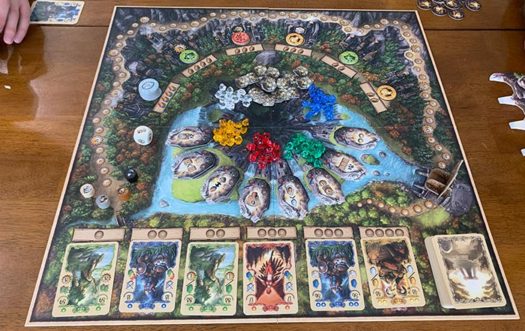
To begin, players choose a player board and take the 8 starting cards matching that player board. They shuffle their deck and draw 4 cards to their hand.
Each card in the game has 3 important elements on it. In the top corners of the card are colored circles that are used as currency to buy more cards. Below those circles are numbers that are referenced when playing cards. And the icons on the sides of the cards indicate what you’ll gain when you play the card.

On a player’s turn, they may take one of the following actions:
- Acquire Cards: The player uses as many cards from their hand showing the same color of circles that they want to spend to buy new creature cards from the board display. The cost of each new card is indicated by the number of circles below the cards in the display. They add the new cards and the cards they used to their personal discard pile. Then they draw back up to their hand limit.

New cards can be purchased at a cost. The circles below show how much. - Play Cards: The player chooses 2 cards from their hand to play and gains what’s listed on the side of both cards. This may include gaining gems, ore, points, or more cards. The player then places the played card with the lower number in their personal discard pile and the higher number card is discarded by the board near the creature deck. Thus, each time a player plays 2 cards for resources, they’ll lose one from their deck. Then they draw back up to their hand limit.
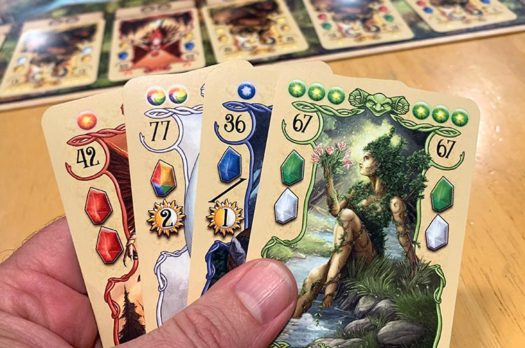
Which two cards should I play? I’ll lose the higher of the two. - Forge Artifacts: The player spends gems to gain up to 2 Artifacts from the board. To gain an artifact, they must pay the number of gems indicated next to the Artifact they want to gain. The gems must be of one type. For example, they must spend 2 gems of the same type to gain the Artifact in the first 2 locations. The gems spent don’t have to match the Artifact color. Some Artifact locations also grant a resource when buying an Artifact there. The player returns the gems to the resource pool and places the gained Artifacts on matching spaces on their player board.
After they’ve completed their 1 chosen action, they may choose to convert Artifacts on their player board to a Rune Stone. Icons at the bottom of the player boards show how many points a player will gain for converting a certain number of Artifacts at a time. For example, if a player converts 2 Artifacts, they’ll gain 3 points. If they convert 5 Artifacts, they’ll gain 15 points!

When they convert Artifacts, they’ll get to choose from the remaining Rune Stones on the board. They’ll add that Rune Stone in a slot at the top of their player board and will gain that special ability for the rest of the game.
These special abilities include more spending power, a larger hand size, playing 3 cards instead of 2, gaining extra points, and such.

As players earn points, they’ll move their marker along the scoring track on the board. Once a player reaches 65 points, it triggers the end of the game. Players finish that round and then total their points. In addition to where they are on the score track, they’ll add points from remaining artifacts and gems on their player board. The player with the most points wins.
Can the whole family enjoy Rune Stones?
Rune Stones is a board game well-suited for older kids and adults. While the gameplay is straightforward, the amount of choices in the game and converting X, to Y, to Z isn’t well-suited for young kids. As such, we’re in agreement with the recommended age of 10+ on the game box.
We have a number of deck-building games and the ones have earned permanent spots on our game shelves are the ones that have unique elements we enjoy. And Rune Stones has earned its spot.
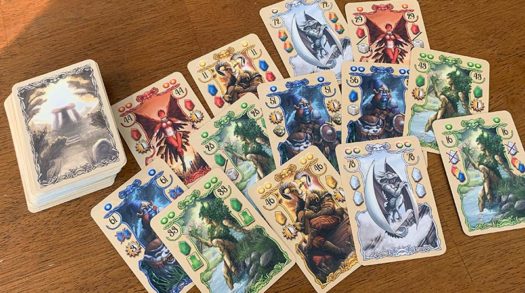
It’s mainly because of the deck-destructing element of the game.
Sure it’s fun to add cards to our decks and have them get more powerful during the game. Yet Rune Stones presents a whole new layer to our choices because it means whenever we play cards to gain resources, we also have to remove one of the cards from our deck! And of course, it will be the card with the higher value.
Then there’s the race to gain Artifacts and in turn Rune Stones.
The Rune Stones grant great abilities to help get ahead in the game. However, there aren’t enough of each type of Rune Stone for every player to get one of the same ability. Plus, during the game, players will on average gain 3 Rune Stones. Yet there are 8 different types of Rune Stones to choose from!
So which Rune Stone do you choose for your first and second?
It can be a tough choice depending on what others are doing.
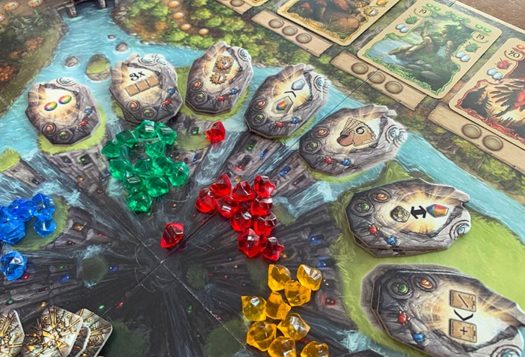
Another thing we like is that the gameplay moves along very quickly. It’s not that it’s a quick game. Each game we’ve played lasted about an hour. But you don’t notice the time going by because your turns come up quickly.
Each player only gets one action on their turn. They make their choice and it’s quickly on to the next player.
At the start of the game, there’s typically a lot of card purchasing going on as players build their decks. But pretty soon someone starts to make a move on gems and before you know it, the race for artifacts and Rune Stones is one.
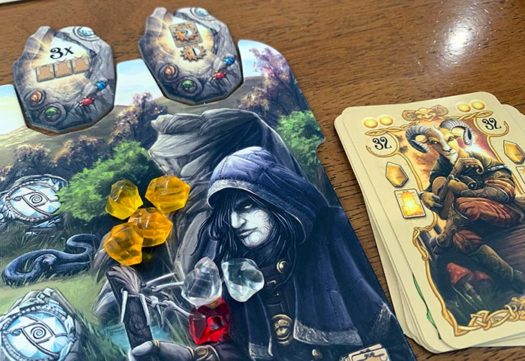
The beauty is that it’s not an all-or-nothing affair. You’ll find that you can’t only buy cards in the beginning and use cards later. If you wait too long to start playing cards for their resources, you’ll find yourself too far behind to ever catch up. But if you start burning your cards too early, you’ll run out of the ability to get more resources too soon and will be buying cards too late in the game while other players are making a dash for the finish line.
It’s a great balance of choices that’s fun to play.
One cool thing that we noticed right away was that the card layout makes it easy to see the information you need no matter which direction your splay the cards in your hand. Tip of the hat to the designers for thinking of that when they put the currency, numbers, and resources to gain on both the left and right sides of the cards!

How does Rune Stones score on our “Let’s Play Again” game meter?
 As we mentioned earlier, Rune Stones has earned a permanent spot on our game shelves. The gameplay is straightforward, yet there are plenty of choices to make throughout the game to keep it interesting.
As we mentioned earlier, Rune Stones has earned a permanent spot on our game shelves. The gameplay is straightforward, yet there are plenty of choices to make throughout the game to keep it interesting.
That being said, the game length is a slight drawback. Even though we don’t notice while we’re playing (because turns fly by), at an hour for a game, it’s not the easiest to play repeatedly. And that’s mostly because there are 4 levels of conversion essentially to get to major points. First you buy cards. Then you use those cards to get gems. Next you use those gems to get artifacts. Then you use those artifacts to get rune stones and points. It’s a long conversion journey.
If we’re looking for a shorter conversion journey, our go-to game is Century: Golem Edition. But if we’ve got a bit more time, we’ll gladly toss in the deck-building, deck-deconstructing fun for Rune Stones.
Thumbs up to Queen Games for another fun board game for our family!
We’d like to thank Queen Games for a review copy of Rune Stones.




